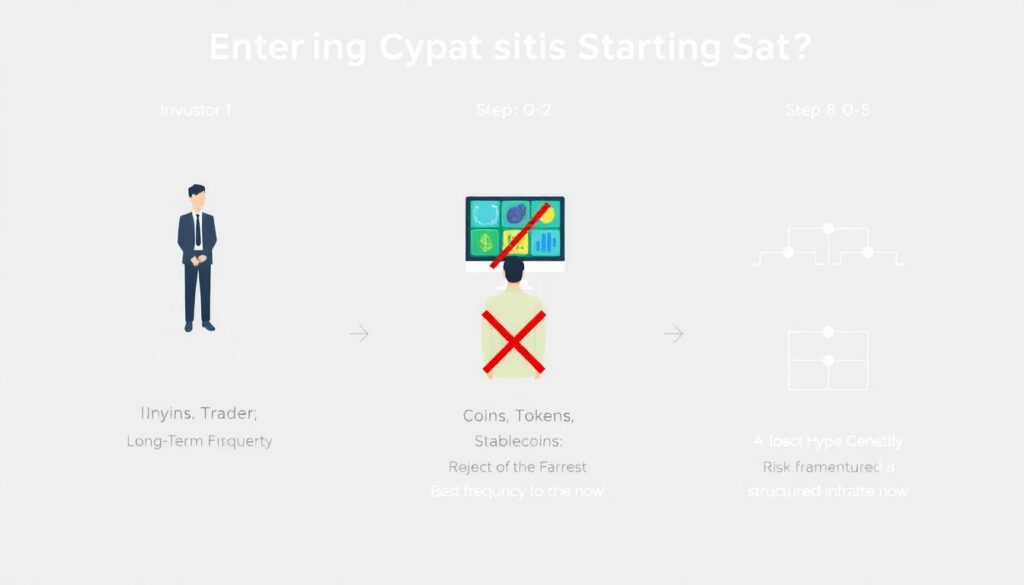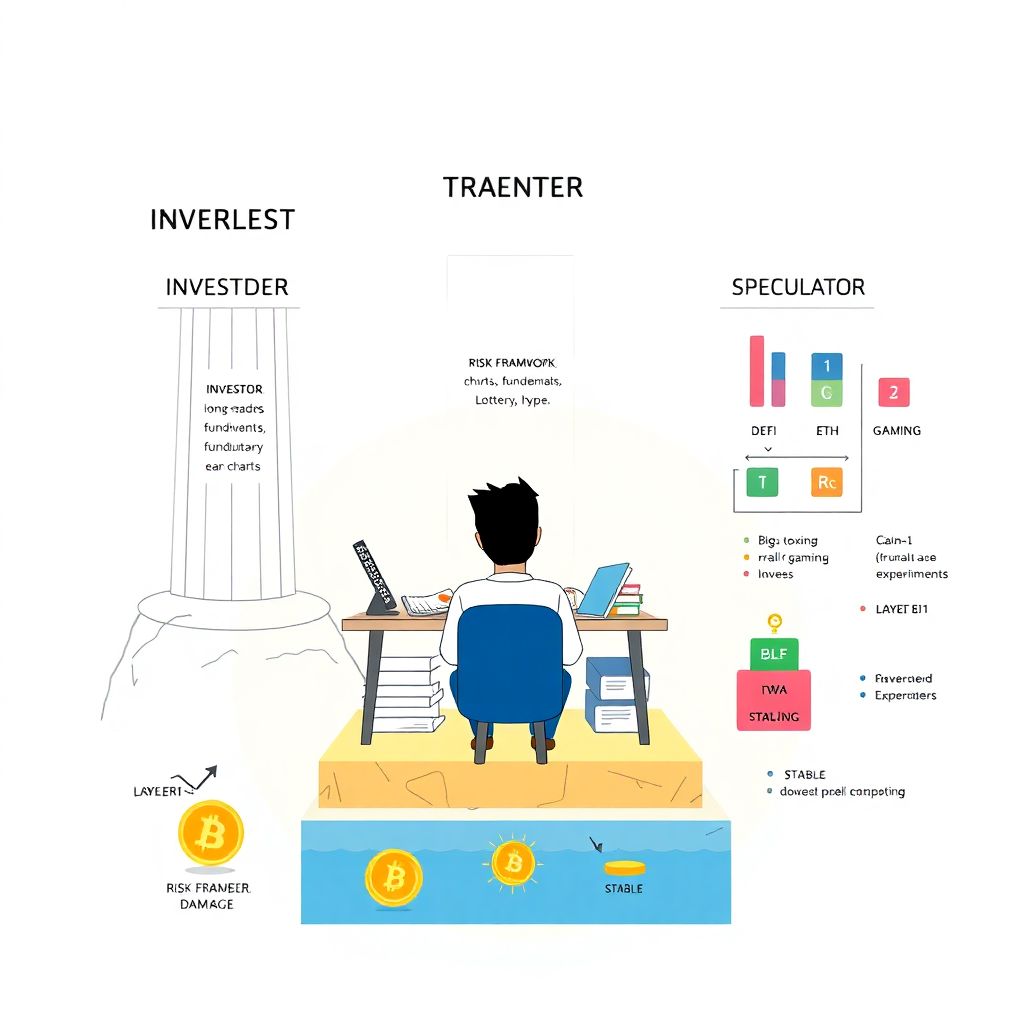Why “Foundational Concepts” Matter More Than Hot Tips
If you’re new to crypto, your feed is probably screaming about the “next 100x coin” and the “best cryptocurrency to invest in right now”.
That noise is exactly why you need foundations.
Crypto is unforgiving to people who skip the basics. Unlike a bank, there’s usually no support line, no “forgot my keys” button, and no regulator to reverse a bad transfer. So the real edge for beginners isn’t secret information. It’s structure, risk management, and a boring understanding of how this game works.
Let’s walk through it step by step, in plain language, with a few unconventional ideas along the way.
—
Step 1. Define Your Role: Investor, Trader, or Speculator?
Before you think about how to invest in cryptocurrency for beginners, you first need to decide what you’re actually trying to do.
1.1 Stop Calling Everything “Investing”
Buying a random meme token because a friend said so is not investing.
It’s a lottery ticket.
Roughly speaking, you have three roles:
1. Investor – You buy assets you understand, with a thesis that might play out over years. You care about fundamentals, use cases, and risk-adjusted returns.
2. Trader – You focus on short- to medium‑term price moves. You care about charts, volatility, liquidity and execution. Fundamentals are secondary.
3. Speculator / Gambler – You chase hype. You care about “number go up” and stories, not data.
Most beginners drift into the third category while believing they’re in the first. Don’t.
Choose intentionally.
Non‑standard tip:
For your first 3–6 months, ban yourself from active trading. Force yourself into the “long‑term investor” role while you learn. It’s a cheap way to avoid paying tuition to the market.
—
Step 2. Learn What You’re Actually Buying
2.1 Coins vs Tokens vs “Everything Else”
At a minimum, understand what sits under the ticker symbol:
– Layer‑1 coins (BTC, ETH, etc.): Base networks. Think of them as “digital infrastructure” akin to the internet itself.
– Tokens (DeFi, gaming, NFTs platforms): They usually live on top of a base chain like Ethereum, Solana, etc. Many have specific roles: governance, utility, fee discounts, and so on.
– Stablecoins: Tokens pegged to fiat (e.g., USD). Useful for parking value or trading pairs, but carry their own risks (issuer, reserves, regulations).
If you can’t explain, in simple terms, what a token does and why it needs to exist, you’re not investing—you’re outsourcing your judgment.
2.2 “Best Coin Right Now” Is the Wrong First Question
Everybody wants the best cryptocurrency to invest in right now. The question you should ask instead:
> “Which assets fit my risk profile, time horizon, and understanding?”
For a beginner, that usually means:
– Start with large, liquid, established assets (BTC, ETH, major L1s).
– Add small exposure to more experimental sectors only after you understand the basics.
Non‑standard tip:
Pick exactly three sectors you’re willing to study for 3–6 months (for example: layer‑1s, DeFi, and real‑world assets). Ignore everything else. Depth beats breadth in crypto.
—
Step 3. Build Your Risk Framework First, Not Last

Most guides jump straight to “how to buy”. Let’s invert that.
3.1 Decide Your “Maximum Damage” Number
Before depositing a cent, define this number:
> “If my total crypto investment went to zero, what is the most I could lose and still sleep well?”
That’s your maximum damage number.
Work backward from there.
– For many beginners, this might be 1–5% of net worth, not including emergency savings.
– Inside that bucket, assume every position could fail—because in crypto, many do.
3.2 Split Money Into Buckets

A simple structure:
1. Safety bucket (off‑chain): Cash, bank deposits, emergency fund.
2. Core crypto bucket: High‑conviction, long‑term positions only.
3. Experimental bucket: Small, capped slice for new ideas and riskier tokens.
Non‑standard twist:
Make your experimental bucket time‑limited. For example, every risky position expires after 6–12 months unless you deliberately re‑approve it. That forces you to review, not just forget.
—
Step 4. Choosing Crypto Trading Platforms for New Investors
4.1 Centralized vs Decentralized: Trade‑offs You Must Accept
Most beginners start on centralized exchanges (CEXes) because they’re easier:
– Email + KYC + bank card.
– Familiar interface.
– Customer support (sometimes).
Decentralized exchanges (DEXes):
– You trade directly from your wallet.
– No custody by a company, but you are responsible for keys and approvals.
– Often more tokens, but also more scams.
You don’t need to pick a religion here. Use a reputable CEX for entry/exit and gradually learn DEXes once you understand wallets.
4.2 Basic Checklist for Platforms
For crypto trading platforms for new investors, prioritize:
– Jurisdiction & regulation – Where is the company legally based? Does it serve your country legally?
– Security track record – History of hacks, insurance, cold storage policies.
– Liquidity – Tight spreads and decent volumes on major pairs.
– On/Off‑ramp – Simple deposits and withdrawals using your local currency.
Red flags:
No information about team, unclear legal entity, or aggressive “earn 50% APR risk‑free!” banners. In crypto, “risk‑free” is marketing code for “you don’t understand the risks yet”.
—
Step 5. Wallets, Keys, and Not Losing Everything
If you only remember one thing:
> “Not your keys, not your coins.”
5.1 Types of Wallets (Simple View)
– Custodial (exchange) wallet – The exchange holds the keys. Convenient but you rely on their security and solvency.
– Software (hot) wallet – App or browser extension. You control the keys, always online, higher risk from phishing and malware.
– Hardware (cold) wallet – Physical device that signs transactions offline. Best balance for serious investors.
Non‑standard rule:
Once the total value of your coins equals more than one month of your income, start planning a move to a hardware wallet and proper backup strategy.
5.2 Seed Phrases and Backups
– Your seed phrase (12–24 words) is effectively your master key.
– Do not:
– Store it in cloud notes or email.
– Type it into “seed checker” websites.
– Take photos of it.
– Do:
– Write it on paper or use a metal backup.
– Store in at least two secure physical locations.
One typo or lost phrase can be a permanent loss. There is no “Reset Password” option.
—
Step 6. Core Cryptocurrency Investment Strategies for Beginners
You don’t need a fancy algorithm. You need something clear, boring, and executable.
6.1 Strategy 1: Dollar‑Cost Averaging (DCA) Into Core Assets
This is the most robust default for new investors:
1. Pick 1–3 major coins you deeply understand and believe in for 5+ years.
2. Invest a fixed amount on a fixed schedule (weekly or monthly).
3. Ignore short‑term noise. You’re buying volatility, not timing it.
This method removes emotional decision‑making and smooths out bad entries.
6.2 Strategy 2: Thesis‑Driven “Barbell”
A slightly more advanced, but still beginner‑friendly idea:
– 80–90% in core assets (BTC, ETH, etc. or your chosen majors).
– 10–20% in high‑conviction experiments in a specific theme (for example: scaling solutions, DeFi blue chips, real‑world assets).
Your barbell is: stability on one side, targeted risk on the other.
6.3 Strategy 3: “No‑Leverage, No‑Derivatives” Policy
For at least the first year, add an explicit rule:
> “I will not use leverage, margin, or complex derivatives.”
Leverage in volatile markets is how beginners blow up accounts in days. If spot volatility already scares you, leverage is just a faster exit from the game.
—
Step 7. How to Build a Crypto Portfolio as a Beginner
Let’s make it practical and structured.
7.1 A Simple 5‑Slot Framework
Instead of thinking in dozens of coins, think in slots:
1. Digital gold / store of value (e.g., BTC‑like assets).
2. Smart contract platforms (e.g., a couple of major L1s/L2s).
3. Infrastructure / DeFi primitives (exchanges, lending, oracles).
4. Thematic bets (gaming, real‑world assets, privacy, etc.).
5. Cash / stablecoin buffer for opportunities and rebalancing.
You don’t need to fill every slot immediately. Start with 1–2 slots and expand only after you can clearly explain what each slot is supposed to do.
7.2 A 5‑Step Portfolio Construction Process
Here’s one way to think about how to build a crypto portfolio as a beginner:
1. Choose your core thesis
For example: “I believe blockchains will be key financial infrastructure over the next decade.”
2. Select 2–4 core assets that directly benefit if that thesis is right.
Example: one store‑of‑value coin, one major smart contract platform, one scaling solution.
3. Assign target percentages to each slot (not each coin).
E.g.: 60% core, 20% infrastructure/DeFi, 10% thematic, 10% stablecoin cash.
4. Enter positions gradually via DCA, not all at once.
This reduces the chance that you buy the exact top.
5. Schedule reviews every 3–6 months.
Rebalance back to targets if any slot drifts too far.
Non‑standard tip:
Treat your portfolio like a research journal. For each coin you buy, write a one‑page memo: why you bought, what could break the thesis, and what would make you sell. The act of writing is more valuable than the prediction itself.
—
Step 8. Information Hygiene: What to Ignore
Your biggest threat isn’t just volatility. It’s noise.
8.1 Build a “Don’t Listen To” List
Explicitly decide which sources you will ignore:
– Anonymous accounts shilling specific coins without disclosures.
– Anyone promising guaranteed returns.
– Influencers whose income comes from selling trading courses they obviously don’t use themselves.
Curate a small, high‑quality feed:
– A few long‑form analysts or newsletters.
– Official project docs and GitHubs.
– Data dashboards (on‑chain metrics, not just price).
8.2 Use Checklists, Not Feelings
Before buying anything, run through a pre‑trade checklist:
1. Do I understand what this project does in 2–3 sentences?
2. Is there real usage or just hype?
3. Who is the team? Any track record?
4. How is the token actually used (or is it just a “number” for speculation)?
5. What is the downside if I’m completely wrong?
If you can’t answer these quickly, you’re not ready to buy. Put it on a “watch and learn” list instead.
—
Step 9. Mistakes Most New Crypto Investors Make (And How to Dodge Them)
9.1 Over‑Concentration in One Coin
New investors often fall in love with the first project they understand.
– Problem: If your identity gets tied to a coin, you’ll ignore warning signs.
– Fix: Cap any single coin at a pre‑defined maximum (say, 20–25% of your crypto bucket).
9.2 Chasing Every New Narrative
Today it’s AI tokens, tomorrow it’s restaked something, next week it’s dog coins with a twist.
– Problem: You’re always late to the party and early to the crash.
– Fix: Commit to your 3 chosen sectors for at least 6 months before expanding. Curiosity is good; compulsive rotation is not.
9.3 Ignoring Fees, Taxes and Friction
Frequent trading in and out of coins on high‑fee networks can quietly burn a big chunk of your capital. Taxes on every realized gain can also hurt if you’re not tracking.
– Fix: Trade less, document more. Use a portfolio tracker and basic tax‑aware planning.
9.4 Security Complacency
You’ll be careful in the first month. Then a year later, you’ll get lazy.
– Fix: Put two recurring reminders in your calendar:
1. Quarterly security review (check backups, device hygiene, permissions).
2. Annual “panic drill”: If this device died today, how would I recover funds?
—
Step 10. Developing an Edge Without Being a Pro Trader
You don’t need to out‑trade hedge funds. You just need an edge appropriate to your scale.
10.1 Your Beginner Edges
– Patience – No investors’ committee forcing you to perform quarterly.
– Small size – You can enter and exit positions that big funds can’t touch without moving the market.
– Willingness to learn deeply about tiny niches.
Non‑standard angle:
Pick one chain or ecosystem (e.g., Ethereum L2s, Solana, Cosmos, etc.) and become “the friend who actually understands that zone”. Your edge is specialization, not being everywhere.
10.2 Measuring Progress Like a Scientist
Instead of just watching your P&L:
1. Track decision quality, not just outcomes.
2. After each major move, write a short post‑mortem:
– What did I think would happen?
– What actually happened?
– Was my reasoning good even if the outcome was bad?
This is how you build genuine skill and not just “I got lucky in a bull market”.
—
Putting It All Together

To summarize the path:
1. Decide your role (investor, trader, or speculator) and commit to low‑frequency, long‑term behavior at the start.
2. Learn what you’re buying—coins, tokens, stablecoins—and stop chasing the “best cryptocurrency to invest in right now” without context.
3. Build a risk framework and a maximum damage number before depositing money.
4. Choose secure, reputable platforms and gradually move toward self‑custody.
5. Use simple, robust cryptocurrency investment strategies for beginners: DCA, barbell, and a strict “no‑leverage” rule.
6. Structure your holdings into a small number of portfolio slots and fill them slowly and deliberately.
7. Maintain information hygiene, checklists, and written theses.
8. Accept that your best advantage as a new crypto investor is not secret information—it’s discipline, structure, and the willingness to learn while everyone else chases the next story.
If you like, describe your current situation (capital size, risk tolerance, country, and time horizon), and I can help sketch a concrete first‑draft plan tailored to you.

